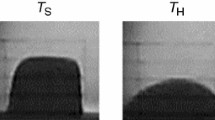Abstract
Mould powders used in the continuous casting of steel play an important role in the heat transfer and lubrication between the liquid metal strand and mould. A range of industrial fluxes was investigated, each sample being decarburized and milled prior to DTA. On heating, the powders undergo silicate crystallization producing exotherms in the range 600°–1000°C, before melting. The activation energy of crystallization (E a) was determined from the peak shifts of each flux heated at different rates, and ranged from 100–450 kJ/mol.E a values increased with flux viscosity and decreased with basicity, suggesting that DTA can be applied to mould powder evaluation for use in continous steel casting.
Zusammenfassung
Abdeckpulver beim kontinuierlichen Gie\en von Stahl spielen eine bedeutende Rolle beim Wärmetransport und beim Schmieren zwischen dem flüssigen Metallstrang und der Form. Es wurde eine Reihe von Industrieflu\mitteln untersucht, wobei jede Probe vor der DTA entkohlt und gemahlen wurde. Beim Erhitzen unterliegen die Pulver vor dem Schmelzen einer Silikatkristallisation, was im Bereich 600°–1000°C zu exothermen Peaks führt. Die AktivierungsenergieE a der Kristallisation liegt im Bereich 100–450 kJ·mol−1 und wurde bei jedem Flu\mittel anhand der Verschiebung der Peaks bei verschiedenen Aufheizgeschwindigkeiten ermittelt. Die Werte fürE a steigen mit der Flu\mittelviskosität und sinken mit der Basizität, was zeigt, da\ DTA zur Bewertung von Abdeckpulvern für das kontinuierliche Gie\en von Stahl angewendet werden kann.
Similar content being viewed by others
References
K. C. Mills, P. Grieveson, A. Olusanya and S. Bagha, Continuous Casting, The Institute of Metals, London 1985, p. 57. 1
N. Nakato, S. Omiya, Y. Habu, T. Emi, K. Hamagami and T. Koshikawa, J. Metals, 36 (1984) 44.
A. Adachi, Z. Morita and Y. Matsumara, Handbook for Physical Properties of Molten Iron and Slag, ISIJ, Tokyo 1972, p. 35.
T. Nakano, T. Kishi, K. Koyama, T. Komai and S. Naitoh, Transactions ISIJ, 24 (1984) 950.
T. Hiromoto, R. Sato and T. Shima, Proc. of NOH-BOS Conf., AIME, Warrendale Pa 1979, p. 93.
J. M. Parker, G. N. Ainsworth, A. B. Seddon and A. Clare, Physics and Chemistry of Glass, 27 (1986) 219.
A. Marotta and A. Buri. Thermochim. Acta, 25 (1978) 155.
Author information
Authors and Affiliations
Rights and permissions
About this article
Cite this article
Dubrawski, J.V., Camplin, J.M. Crystallization of mould powders used in the continuous casting of steel. Journal of Thermal Analysis 40, 329–334 (1993). https://doi.org/10.1007/BF02546583
Published:
Issue Date:
DOI: https://doi.org/10.1007/BF02546583




